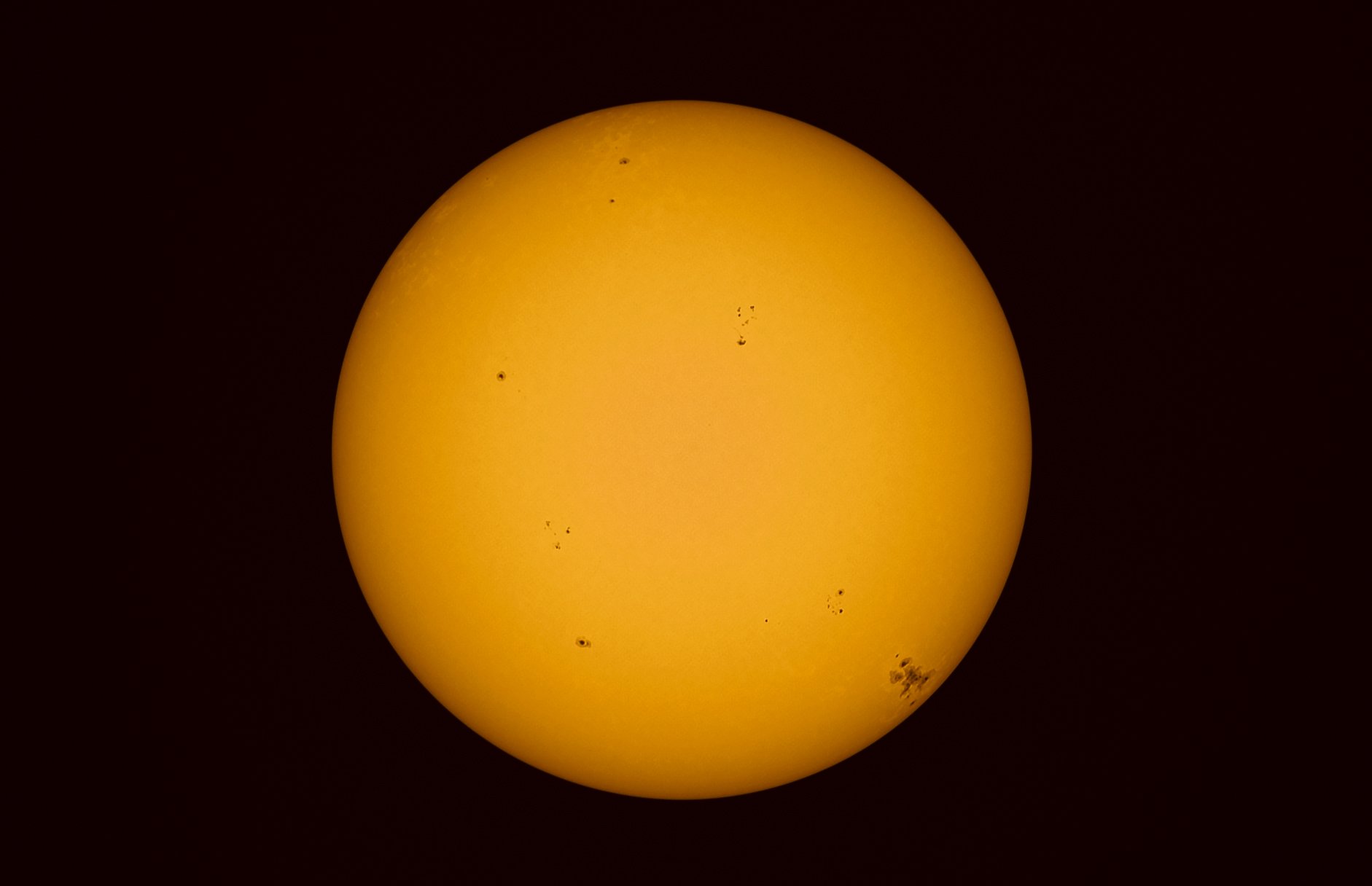The Camera is a Liar
I have often stated that the camera is a liar. Why? Well I must first establish that the real "truth" teller in all of this is the human eye and brain. This can be debated, but for now please just accept this notion. Now that we have established what is truth, it is quite simple to prove that the camera is a liar. Many "purists" insist on no "manipulation" of an image; simply let the camera record the "truth." Nothing could be further from reality. There are many scientific differences between the human eye/brain interpretation of light and the digital sensor. The purpose of this post is not to regurgitate what others have written, so I simply forward you to the fantastic webpage by Roger Clark where he addresses the differences between the human eye and camera sensors/lenses.
I simply wanted to present an image that I recorded in the spring and demonstrate how the camera recorded the image and how my eye interpreted the scene. The image is from Douglas Falls in West Virginia where we had our first "Flowing Water Workshop" in May. The scene is a beautiful flowing stream in late morning. The light is bright sun on the left side of the image and blue sky illuminated shadows in the lower parts of the canyon. As you can see from the 3 images posted below, the camera simply cannot record the entire range of light with one capture.
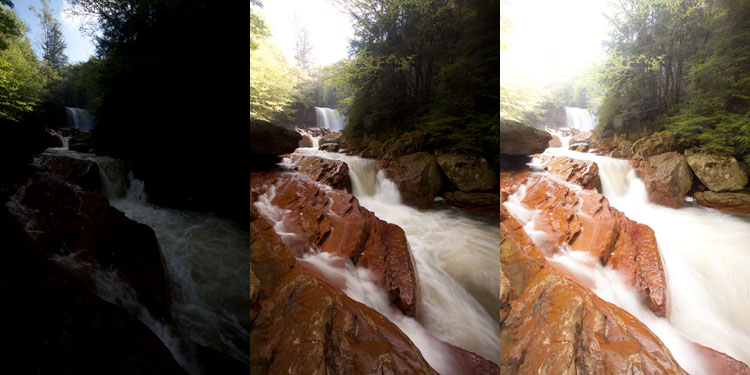
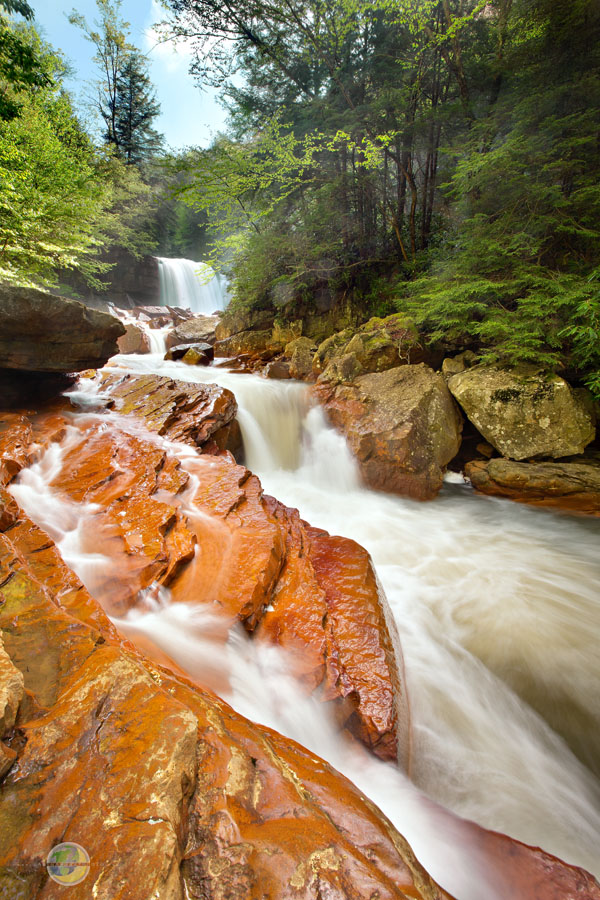 Douglas Falls OptimizedThere are two things that are important for the photographer to understand; how the camera is going to record a particularly beautiful but challenging scene and how to process the data afterwards so that the final image meets the interpretation of the photographer. This is what we focus on in our workshops and post-workshop teaching. The final image of Douglas Falls is posted on the left. This is how I interpreted the scene that day and is much closer to "reality" than any of the 3 images pictured above taken by the camera.
Douglas Falls OptimizedThere are two things that are important for the photographer to understand; how the camera is going to record a particularly beautiful but challenging scene and how to process the data afterwards so that the final image meets the interpretation of the photographer. This is what we focus on in our workshops and post-workshop teaching. The final image of Douglas Falls is posted on the left. This is how I interpreted the scene that day and is much closer to "reality" than any of the 3 images pictured above taken by the camera.
Please click on the image or here for a higher resolution image.
"Mountains of Color" fall photography workshop registration is now OPEN
 Tree Portrait-Dolly Sods National Recreation AreaHello! I am very excited to announce that the registration for the "Mountains of Color" fall photography workshop is now OPEN. Please review the website and if this workshop looks like one you would like, please register early and secure your hotel or camping accomodations early as spaces are filling up fast. This is one of the golden times to be in the highlands of West Virginia. Not only will we be in the midst of beautiful scenery, we will be learning some great photography approaches and developing friendships with fellow photographers. It is a great fun learning environment. If you have any questions please don't hesitate to contact me. I hope you can join us for this great weekend of beautiful photography.
Tree Portrait-Dolly Sods National Recreation AreaHello! I am very excited to announce that the registration for the "Mountains of Color" fall photography workshop is now OPEN. Please review the website and if this workshop looks like one you would like, please register early and secure your hotel or camping accomodations early as spaces are filling up fast. This is one of the golden times to be in the highlands of West Virginia. Not only will we be in the midst of beautiful scenery, we will be learning some great photography approaches and developing friendships with fellow photographers. It is a great fun learning environment. If you have any questions please don't hesitate to contact me. I hope you can join us for this great weekend of beautiful photography.
Workshop Exercises: Interpreting the Scene
Below are some comments I wrote in a follow-up to our workshop students from Flowing Water held one week ago. We work on many skill enhancement exercises while in the field. This particular exercise reinforces the importance of interpreting the scene as one feels it and sees it vs. how the camera sees the scene. Here are the comments regarding a specific forest scene in which we were photographing.
One particular skill we we worked on involved interpreting the scene. Sometimes we must reconcile what the camera "sees" with what we are "seeing and feeling" at the moment of capture. We discussed the importance of noting when the camera records a scene in a way that is radically different from the one you experienced.  You may recall one particular scene that really exemplified the importance of noting the differences between what the eye sees vs. what the camera records. The scene pictured here is from Cathedral Forest where we had moments of very nice warm morning light. The left image is exactly how the camera interpreted the scene. While you were reviewing the image on your LCD screen you may have wondered "why does this light seem much brighter and less colorful than what I am seeing?" Many times we are photographing in mixed light. Just like in this scene where we have cool open shade light as well as direct horizontal morning light. It is very challenging for the camera to automatically interpret the scene accurately, let alone how we felt in the scene at the moment of capture. That is really what it is about, capturing the scene as we saw and felt it at the moment of capture. There is no doubt that the light was very nice in this scene and we all responded to it by taking photos.
You may recall one particular scene that really exemplified the importance of noting the differences between what the eye sees vs. what the camera records. The scene pictured here is from Cathedral Forest where we had moments of very nice warm morning light. The left image is exactly how the camera interpreted the scene. While you were reviewing the image on your LCD screen you may have wondered "why does this light seem much brighter and less colorful than what I am seeing?" Many times we are photographing in mixed light. Just like in this scene where we have cool open shade light as well as direct horizontal morning light. It is very challenging for the camera to automatically interpret the scene accurately, let alone how we felt in the scene at the moment of capture. That is really what it is about, capturing the scene as we saw and felt it at the moment of capture. There is no doubt that the light was very nice in this scene and we all responded to it by taking photos. 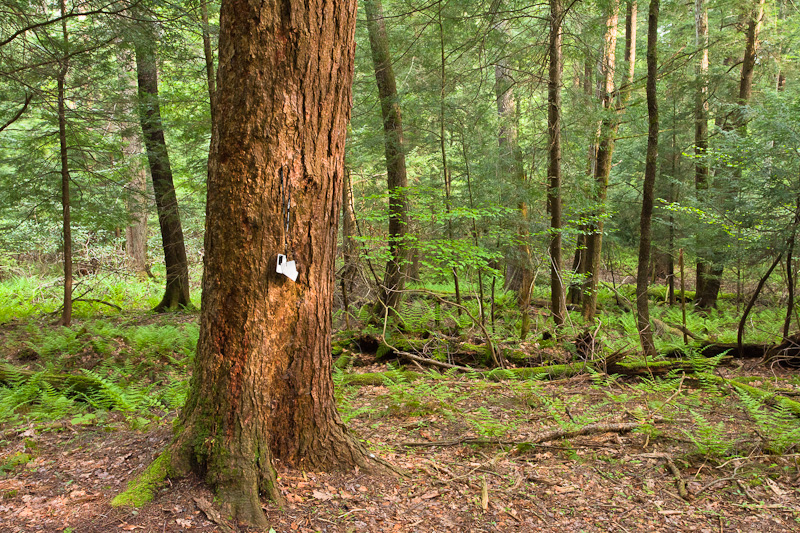 So what can we do? In this case it is a simple technical adjustment that can make all of the difference. The camera recorded the scene with a temperature of 3839 and a tint of 24. As you can see I hung the White Balance card in the scene where the light was touching the tree. Simply using this card as my white balance reference the scene changes completely to the accurate presentation in the image on the right. Now the temperature is 4850 and the tint is 15. The white balance card doesn't always work, but in this case I think it has done a nice job in interpreting the scene of warm morning light with the greens of the forest.
So what can we do? In this case it is a simple technical adjustment that can make all of the difference. The camera recorded the scene with a temperature of 3839 and a tint of 24. As you can see I hung the White Balance card in the scene where the light was touching the tree. Simply using this card as my white balance reference the scene changes completely to the accurate presentation in the image on the right. Now the temperature is 4850 and the tint is 15. The white balance card doesn't always work, but in this case I think it has done a nice job in interpreting the scene of warm morning light with the greens of the forest.
This is just one example of the skill enhancement exercises we worked on during our time together. I encourage you to continue to utilize the skill enhancement exercises in your daily photographic adventures. Again if you need any other help we can work together either via VOIP or phone or you can attend another workshop.
Andromeda Galaxy 2010
 The Great Andromeda GalaxyIf you have followed previous blog posts you know that I have been working on this image for some time. I apologize that I did not provide more intermediate updates, but here is the final image as it will be printed on my Epson 7800. You may want to reference earlier posts about making a print of Andromeda beginning on September 15. You can see the initial RAW image at initial capture and compare to the finished image. As Ansel said, "you don't take a photograph, you MAKE a photograph."
The Great Andromeda GalaxyIf you have followed previous blog posts you know that I have been working on this image for some time. I apologize that I did not provide more intermediate updates, but here is the final image as it will be printed on my Epson 7800. You may want to reference earlier posts about making a print of Andromeda beginning on September 15. You can see the initial RAW image at initial capture and compare to the finished image. As Ansel said, "you don't take a photograph, you MAKE a photograph."
It is always a pleasure to revisit familiar astronomical objects and the Great Andromeda Galaxy is certainly one of the finest. This past August we had the opportunity to capture the galaxy from the fabulous dark skies of The Mountain Institute on Spruce Knob in West Virginia during the Almost Heaven Star Party. The galaxy is a marvel to behold as one of our local neighborhood galaxies that stretches over 220,000 light years across. It is the farthest deep sky object that can be seen with the unaided eye and is located at a distance of over 2,000,000 light years away. The galaxy is easily seen from the dark skies of Spruce Knob with the unaided eye. The diffuse glow of the galaxy is caused by billions of stars shining throughout the galaxy's disk. Andromeda is classified as a spiral type of galaxy. For more information and to view the image in the black portfolio screen (the best view) please click here.
Creating a Print: Part 2
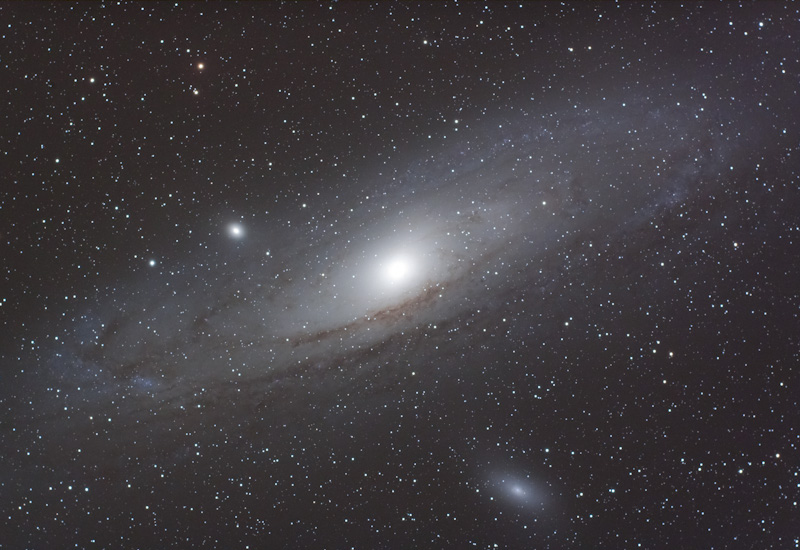 M31 RAW converted and ready for stacking
M31 RAW converted and ready for stacking
Several corrections are made in Adobe Light Room 3.0 (LR) with the image. First the image is rotated to a more pleasing angle of view. This is the presentation angle in which I originally envisioned the galaxy before capture. One of the most important things we do in LR is attempt to get the color balance as accurate as possible. It is important that all sharpening be turned "off" in LR. Sharpening can cause distortion and artifacts in the stars. I then apply an appropriate amount of noise reduction. This is where LR 3.0 really stands out. The new luminance and color noise reduction controls are outstanding for astrophotography. It is important to not over-smooth as we want normal luminance noise to be reduced by subsequent stacking of photos. Now that I have my RAW file ready for conversion, I simply apply the same corrections to the other RAW files and prepare them for stacking.
Jeff's Blog
Join me on photography journeys from desert landscapes to deep sky wonders.




